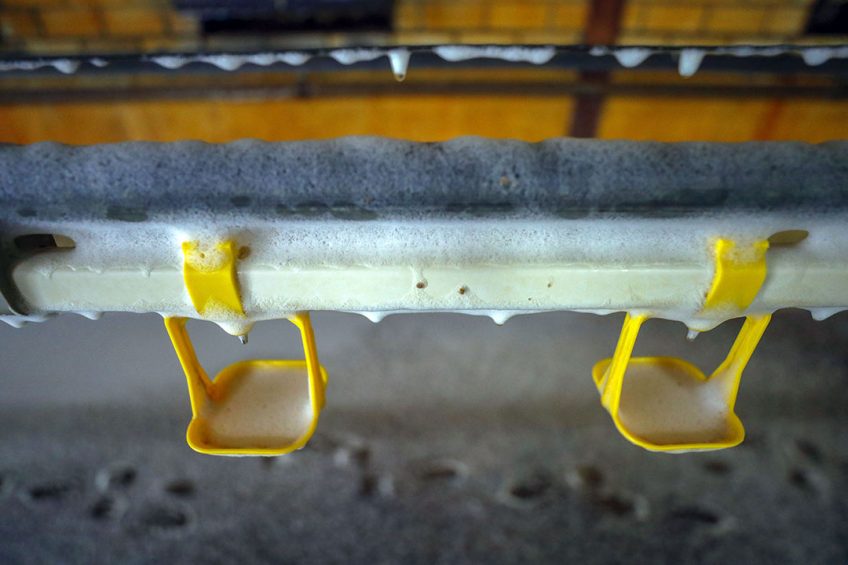Viral status in need of attention

A pilot study on viral status at broiler farms is ongoing with the aim of increasing awareness of the importance of cleaning and disinfecting broiler houses.
In general, viral status is not given sufficient attention when broiler barns are cleaned, says Richard Rietema, poultry vet and co-owner of Poultry Practice North & East in the Netherlands. Rietema would like to see more attention focused on the viral status of broiler farms. Virus types such as rota (A and D), astro, reo and nephritis can cause a lot of problems. Using the PCR technique progress has been made in measuring the pressure caused by these viruses. Rietema is still cautious, however. “A pilot is running right now. Researching and measuring viral status at broiler farms is still in its early stages.” How do broiler farmers check whether their recently cleaned broiler barn is spotless? “A standard hygiene chart gives you a good impression of the bacterial status, but that is not enough,” Rietema explains. “A hygiene chart measures the bacterial state, and not the viral state.”
Enteric viruses
When are poultry houses clean enough? That is hard to say at the moment, says Janny Hermans, poultry vet and co-owner of AdVee. “It is often limited to a visual inspection. However, with a hygiene chart you can only measure bacterial pressure.” As a poultry vet, Hermans is closely involved in a pilot measuring the viral status on broiler farms. “Enteric viruses can cause a lot of damage. As soon as1-day-old chicks encounter high viral pressure, you know that the start of this chick was suboptimal and that the cleaning process of your poultry barn needs extra attention. Heightened viral or bacterial pressure, together with other causes like chick quality, too cold houses at the beginning and so on, can trigger the multifactor MAS syndrome. MAS causes clinical and subclinical problems in chicks, which leads to bad technical results.”
The pilot tests for the presence of 5 viruses: rota (A&D), astrovirus, aviary nephritis and reo. Hermans continues: “These 5 viruses are extremely infectious and highly resistant which means they are hard to remove from the broiler house. We know that reo can pass vertically from the parent stock through the egg to the chick and can remain inside the poultry house. Astrovirus and AVN can pass vertically, but Rota A en D cannot. A chick is infected by these viruses inside the poultry shed on day 1 and virus multiplication takes place in the intestinal cells. A replicating virus damages these cells. Reduced viral pressure leads to a better start for the chick. Excretion of these viruses is at its peak on day 7 which is also when cloaca swabs are taken. This VirCheck provides a measure for the cleaning process.” But more important, the VirCheck offers an opportunity to discuss the cleaning process and the start of a flock. It should not be a black and white result to pinpoint to someone. Together with the farmer, feed mill representative and perhaps the cleaning company you should try to explain the outcome of the VirCheck and see wat everyone can do to optimise the efforts.
Measurable viral pressure
Tests are ongoing at several broiler farms. On day 7, about 10 chicks per flock are examined by means of a Polymerase Chain Reaction (PCR). Swabs are taken inside the cloaca which are sent to the Dutch Animal Health Service (GD) using ‘FTA cards’. The GD then checks for any of the 5 viruses. “The cost is about €89 per test run. The results are especially important for the next set of chicks. With the results in hand we can analyse what improvements we can make,” says Hermans

The pilot is providing a real treasure trove of information. The data obtained will eventually lead to a validated test of the viral pressure in poultry houses. “We must set up correct limit values. Up to what point is the viral pressure acceptable and when do we need to act? We want to develop a traffic-light method, so you can see at a glance what the viral pressure in your company is. We want to start working with benchmark data as well, so farmers can compare their own status with that of other companies.”
The pilot may also provide more clarity about the harmful effects of the five enteric viruses. “The research results should show us which viruses cause the most problems,” Hermans says. As far as she is concerned, the pilot’s main goal is to create more awareness about cleaning broiler barns. Bacteria and viruses can still be present in a seemingly spotless barn. “We want to quantify that so we can learn from it. That should eventually lead to improvements.” Hermans is not saying that broiler houses are not properly cleaned in general. “Poultry farmers and cleaning crews truly want to do things to the best of their ability. With a PCR of five viruses, we can show whether improvements are needed or not.”
Methodical cleaning
Research on measuring and analysing broiler farm viral states is still ongoing. Richard Rietema, however, is positive about the initial results. Some broiler farms are already benefitting from the methodical approach to cleaning that was implemented after measuring and examining their viral status. “The first improvements are already visible. Some poultry barns are performing better technically, with fewer problems coming to light.”
With a better picture of their companies’ viral status, broiler farmers can clean in a way which is more focused. “In practice, I see many different ways of cleaning broiler barns. Some companies use agents with a limited shelf life. Some agents are not used correctly or with the proper methods,” says Rietema. As a poultry vet, Rietema is a proponent of formalin use. “Some poultry farmers hate using it. It is not a pleasant agent but it helps keep viral pressure in check,” Rietema indicates, who also notes that avoiding formalin does have an impact.
In Hermans’ view, using formalin is only part of a complete cleaning process. “It is a powerful agent for disinfecting broiler sheds. However, cleaning thoroughly goes beyond just using formalin. A longer empty period between flocks also works well in lowering infection pressure.” Hermans notes that multiple factors are important in the cleaning process of a broiler house. “What exactly do you do? How long do you keep broiler houses empty and how much time do you reserve for cleaning? Do you soap, rinse and disinfect the barn? What is the application time? Which agents do you use and in what dosage? How much water do you use? Do you let the house dry properly? It is wise to check carefully whether or not the cleaning method really is good enough.”
Viral component underestimated
Rietema believes that methodical cleaning with formalin, for example, should be part of more extensive operating procedures. “Cleaning is just part of the business operations. It’s all about ensuring rest, cleanliness and regularity. It is a fact that the sector underestimates the viral component.” Rietma does not rule out that some broiler farmers may have unjustly complained about the quality of day-old chicks and feed in the past. But by devoting more attention to the viral status of their companies, they could identify where things are going wrong, he thinks. “But of course, it is always good to remain critical of your suppliers.”








